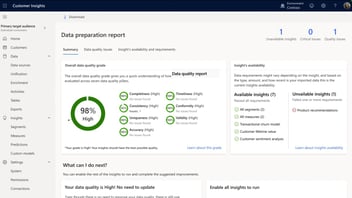Lead Marketing: A Great Strategy for ROI-Focused Teams
Marketing encompasses many different qualities. The ability to read a customer and the power to get creative are just a couple parts of the process.
Though these things are important, the main selling point for any marketing strategy is how much of a return it offers. Sure, companies may appreciate their marketing departments’ ability to be inventive – but how are those efforts affecting the bottom line?
Lead marketing is a smart way to put ROI at the centre of a marketing plan. Marketing for leads over traffic is a sure way to ensure a marketing effort is built around delivering a return.
Combine these efforts with high-quality marketing and sales platforms like Microsoft Dynamics 365, and there’s no limit to how successful a lead marketing strategy can be.
What is Lead Marketing? What Sets it Apart?
Lead marketing is a field of marketing with plenty of buzz around it. Given that 65% of businesses say generating traffic and leads is their biggest challenge, any help is appreciated.
Leads represent prospective sales and thus prospective revenue. When a marketing team is trying to prove the value of their services and even individual campaigns, focusing on ROI is a winning strategy.
The idea behind lead marketing is that traffic isn’t all that matters. While some sites would love to have ad get millions of clicks or a piece that goes viral overnight, this doesn’t automatically mean they’ll have a greater return.
A smaller pool of traffic with a larger lead percentage can be preferable. If a company brings in a million users through traffic generation, say with SEO for example, they may find their lead percentage from that traffic is only 1%. Now, what about a company that brought in 500,000 new visitors, but had a lead percentage of 3%? The former has more traffic, but the latter has more leads, always consider the lead percentage and lead potential.
Lead marketing can involve the use of several methods to bring traffic with high lead potential. These may include longtail keywords, email campaigns based on data insights, and more.
Which Tools Work Best for Lead Marketing?
Shifting the focus of a marketing campaign to leads means sales numbers are on the line. When a team is aiming to improve ROI, they need the right tools. Not only can the useful tools help them attract more leads, but it can also help them generate sales.
Here are some powerful tools used in modern lead marketing, and the benefits they bring:
- Microsoft Dynamics 365: Gain insights for better lead generation and sales success from a holistic platform.
- Microsoft Dynamics AI: Automate the cumbersome tasks of data gathering and organization to keep insights on hand at all times.
- Microsoft Power BI: Chase quotas and gain sales data which is useful for bringing in future leads.
Additional tools for social engagement, team collaboration, and mobile platforms can also be helpful. While these tools may be different, the unifying factor among them is they speed up and streamline the processes all companies follow.
Whether the process is gathering insights, organizing them, or even putting them into action with a sales strategy, having the proper tools can help any organization improve their chances of success.
Teams can come in many shapes and sizes. Not every marketing department or team is equal. The size, financing, and skillsets may all be unique. The benefit of these tools is also that they are flexible. Users can create the type of support system they need based on the way their team works.
How Marketing Teams Prove Their Worth
There’s no denying that marketing is a crucial part of any successful business. Marketers often find themselves facing discussion about whether their efforts are benefiting the company.
Some people view savvy marketers as artists and creative types who come up with great ideas – but don’t always contribute most to their business. Lead marketing is a way for teams to prove their worth. ROI-focused marketing is a way to revitalize this cornerstone of the common business.
The marketing department of a company is one of its most expensive. Consider how many different aspects are associated with the standard marketing process:
- Preliminary Stages: Research, strategy, and planning.
- Main Stages: Copywriting, editing, and posting.
- Follow-Up Stages: Promotion, monitoring, and updating.
Through these stages, we can see many costs arise. Everything from paid promotions to buying rights for media can function as an expense.
The best strategy for marketers is to make these expenses look like an investment by showing ROI opportunities at every step. The preliminary stages can provide valuable assets for long-term use. Optimized content can draw lead-heavy traffic. Following up can keep content delivering returns for months or even years to come.
Leads Bring ROI to the Forefront of Marketing
Teams and companies must be focused on ROI, no matter how many steps are involved along the way. Using lead marketing can help marketers show their worth, and deliver the sales the company needs.
Are you looking to learn more about Microsoft Dynamics 365, Power Bi, Logic Apps, or any of the other tools that can transform your business? Visit Crimson to take part in a workshop for Assess2Progress or Microsoft’s Art of the Possible.

-Jun-01-2021-10-59-43-02-AM.png?width=352&name=Hubspot%20Blog%20Banner%20(1)-Jun-01-2021-10-59-43-02-AM.png)
